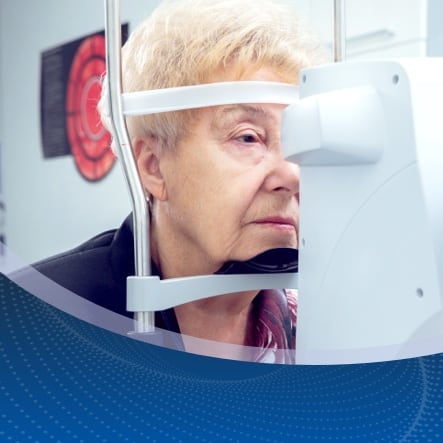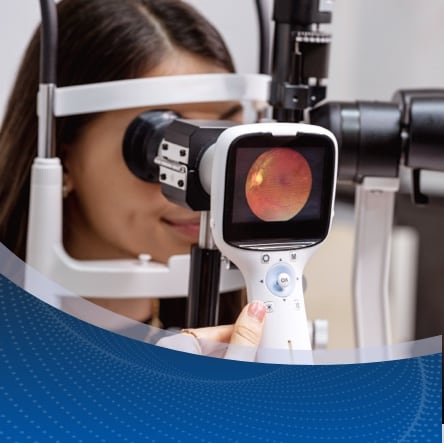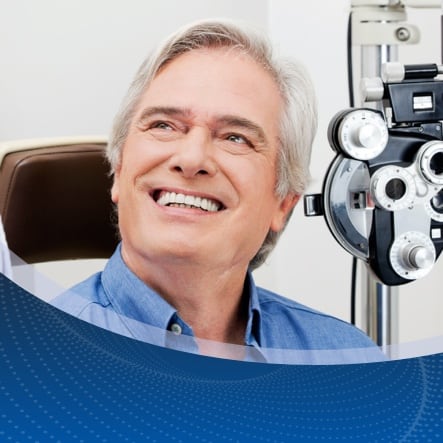Reviewed By: Dr. Paul M. Griffey
Blurred vision and a throbbing forehead may seem like separate problems. Many patients soon discover they’re linked. Can cataracts give you headaches? The short answer is yes. When the eye’s clear lens turns cloudy, light scatters instead of focusing. The muscles that fine-tune vision must strain all day just to keep text legible and road signs readable. That hidden workout often surfaces as a dull ache behind the eyes that creeps into the temples and crown.
How a Cloudy Lens Sets the Stage for Pain
In a healthy eye, the crystalline lens bends incoming light into a crisp point on the retina. A cataract disrupts that clarity. Proteins bunch together, creating fog that blurs edges and washes out color. Without thinking, you squint, lean closer to the page, or tilt your head to dodge glare. Each adjustment tightens both tiny ciliary muscles and larger facial and neck muscles, laying the groundwork for tension headaches. The longer your eyes wage this battle, the more that pulling sensation builds.
Why Eye Strain Feels Like Head Pressure
Cataract-related discomfort rarely stays confined to the eyes. As light scatters, the brain receives incomplete signals. It keeps urging the focusing muscles to try harder. Over time, that effort spreads outward, squeezing the brow and wrapping a band of pressure around the scalp. Many patients wonder whether cataracts can cause head pressure because the sensation often mimics sinus congestion, until closing the eyes brings quick relief.
Glare, Halos, and the Migraine Question
Bright headlights or office fluorescents become double threats when the lens is cloudy. Stray rays bounce inside the eye, creating halos that force even more squinting. Although cataracts rarely spark a true neurological migraine by themselves, the amplified glare can lower the threshold for someone who is already susceptible. If light triggers or intensifies your attacks, review the difference between lens-induced glare and a classic ocular migraine to pinpoint what you’re dealing with. Untreated cataracts can cause migraines indirectly, by feeding the visual stress that tips a sensitive system into an episode.
Clues Your Headache Starts in Your Eyes
Vision-related headaches follow a predictable rhythm. Pain builds during close work—editing spreadsheets, reading small print, scrolling a phone—and fades after ten minutes of eye rest. Night driving can be particularly troublesome. Glare halos around streetlights force constant squinting, and the ache sometimes arrives before the next exit. If those patterns sound familiar, the link between cataracts and headaches deserves your attention.
Small Changes for Daily Relief
Before surgery enters the discussion, modest adjustments can ease the strain:
- Improve lighting: Swap harsh overhead bulbs for diffuse task lamps to soften shadows without leaving rooms dim.
- Enlarge text and boost contrast: Larger fonts and bold settings allow eyes to relax.
- Use the 20-20-20 habit: Every twenty minutes, look twenty feet away for twenty seconds to loosen the focusing muscle.
- Check your posture: A level chin helps keep neck muscles loose and reduces the band-like pressure that many cataract patients report.
None of these steps clears the lens, but each buys comfort while you weigh long-term solutions.
Will Cataract Surgery End the Headaches?
Most patients notice relief within days of surgery. The procedure removes the opaque lens and replaces it with a clear intraocular implant. Once light travels cleanly again, the eyes stop fighting for focus. Eye-care studies consistently show that sharper vision leads to fewer tension headaches because the original trigger—constant visual effort—has disappeared. If pain lingers, your ophthalmologist will investigate other potential culprits, such as dry eye, sinus issues, or unrelated migraine disorders.
When a Doctor’s Visit Can’t Wait
Book a comprehensive exam soon if headaches accompany growing blurriness, frequent glare halos, or trouble reading street signs at dusk. Seek immediate care if you experience sudden vision loss, flashes of light, severe pain with nausea, or any new neurological symptoms. Cataracts usually progress gradually; rapid or dramatic changes deserve prompt evaluation.
Quick-Reference FAQs
What symptoms suggest your headache might be vision-related?
Head pain that intensifies during reading, screen use, or night driving and calms when the eyes rest points toward a visual trigger. Blurred outlines, light sensitivity, or a burning sensation strengthen the case.
Do cataracts cause migraines or just mild headaches?
Most people experience tension-style aches or a sense of head pressure. Migraines typically emerge when glare magnifies an existing sensitivity.
Will cataract surgery relieve my headaches?
Often, yes. Clearer images mean less squinting and far fewer strain-based triggers. Persistent headaches afterward call for a broader medical work-up.
Are headaches a sign that cataracts are worsening?
A sudden uptick in headache frequency can indicate a denser lens cloud that makes the eye work harder. Regular exams track that progression and help you choose the right time for surgery.
The Bottom Line
Headaches tied to cataracts rarely improve on their own. Modern surgery restores clear vision for millions and just as often quiets the nagging ache that clouded lenses create. If blurry sight and daily pain sound familiar, schedule an exam. Clarity for your eyes may bring calm to your head—proof that treating one problem can solve two.
Call 1-888-873-9348 or schedule an eye exam online at our Chesapeake location.
**Please note that the suggestions provided in this blog are for general informational purposes only and may not be suitable for your specific insurance plan and needs. It is important to consult a qualified healthcare professional for personalized advice and treatment.**












